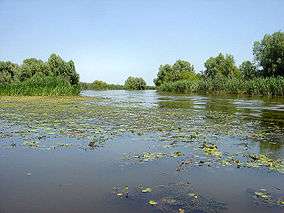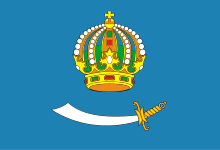Astrakhan Oblast
| Astrakhan Oblast Астраханская область (Russian) | |||
|---|---|---|---|
| — Oblast — | |||
| |||
|
| |||
| |||
|
| |||
| Political status | |||
| Country | Russia | ||
| Federal district | Southern[2] | ||
| Economic region | Volga[3] | ||
| Established | December 27, 1943[4] | ||
| Administrative center | Astrakhan | ||
| Government (as of April 2014) | |||
| • Governor[5] | Alexander Zhilkin[6] | ||
| • Legislature | State Duma[7] | ||
| Statistics | |||
| Area (as of the 2002 Census)[8] | |||
| • Total | 44,100 km2 (17,000 sq mi) | ||
| Area rank | 55th | ||
| Population (2010 Census)[9] | |||
| • Total | 1,010,073 | ||
| • Rank | 52nd | ||
| • Density[10] | 22.9/km2 (59/sq mi) | ||
| • Urban | 66.7% | ||
| • Rural | 33.3% | ||
| Population (January 2013 est.) | |||
| • Total | 1,013,800[11] | ||
| Time zone(s) | SAMT (UTC+04:00)[12] | ||
| ISO 3166-2 | RU-AST | ||
| License plates | 30 | ||
| Official languages | Russian[13] | ||
| Official website | |||
Astrakhan Oblast (Russian: Астраха́нская о́бласть, Astrakhanskaya oblast) is a federal subject of Russia (an oblast). Its administrative center is the city of Astrakhan. Population: 1,010,073 (2010 Census).[9]
Geography

stan
*Smaller areas along the north Caucasus are the republics: Karachay-Cherkessia, Kabardino-Balkaria, North Ossetia-Alania, Ingushetia, and Chechnya
*Yellow is the Southern Federal District and Pink is the North Caucasus Federal District
Astrakhan is traversed by the northeasterly line of equal latitude and longitude. Its southern border is the Caspian Sea, eastern is Kazakhstan, northern is Volgograd Oblast, and western is the Republic of Kalmykia.
It is within the Russian Southern Federal District.
History
The oblast was created on December 27, 1943, on parts of the territories of the abolished Kalmyk ASSR and Astrakhan Okrug of Stalingrad Oblast.[4]
From 1980 to 1984, the USSR held a series of nuclear tests in the oblast less than 50 km from downtown Astrakhan.
Politics
During the Soviet period, the high authority in the oblast was shared between three persons: The first secretary of the Astrakhan CPSU Committee (who in reality had the biggest authority), the chairman of the oblast Soviet (legislative power), and the Chairman of the oblast Executive Committee (executive power). Since 1991, CPSU lost all the power, and the head of the Oblast administration, and eventually the governor was appointed/elected alongside elected regional parliament.
The Charter of Astrakhan Oblast is the fundamental law of the region. The Legislative Assembly of Astrakhan Oblast is the province's standing legislative (representative) body. The Legislative Assembly exercises its authority by passing laws, resolutions, and other legal acts and by supervising the implementation and observance of the laws and other legal acts passed by it. The highest executive body is the Oblast Administration, which includes territorial executive bodies such as district administrations, committees, and commissions that facilitate development and run the day to day matters of the province. The Oblast administration supports the activities of the Governor who is the highest official and acts as guarantor of the observance of the oblast Charter in accordance with the Constitution of Russia.
Administrative divisions
Demographics

Population: 1,010,073 (2010 Census);[9] 1,005,276 (2002 Census);[14] 998,114 (1989 Census).[15]
- Ethnic groups
According to the 2010 Census, the ethnic composition was:[9]
- Russian 67.6%
- Kazakh 16.3%
- Tatar 6.6%
- Ukrainian 0.9%
- Nogay 0.8%
- Chechen 0.8%
- Azeri 0.9%
- Kalmyk 0.7%
- Armenian 0.6%
- Roma 0.6%
- Avar 0.5%
- Lezgin 0.5%
- Dargin 0.5%
- Belarusians 0.3%
- Others 2.4%
- 95,217 people were registered from administrative databases, and could not declare an ethnicity. It is estimated that the proportion of ethnicities in this group is the same as that of the declared group.[16]
- Births (2008): 14,200 (14.2 per 1000)
- Deaths (2008): 13,660 (13.6 per 1000)
- Vital statistics for 2012
2009 - 1.77 | 2010 - 1.76 | 2011 - 1.78 | 2012 - 1.93 | 2013 - 1.91 | 2014 - 1.97 | 2015 - 1.96(e)
Religion
According to a 2012 official survey[19] 46% of the population of Astrakhan Oblast adheres to the Russian Orthodox Church, 4% are Orthodox Christian believers who do not belong to any church or are members of other (non-Russian) Orthodox churches, 2% are unaffiliated generic Christians, 14% are Muslims, and 2% of the population adheres to the Slavic native faith (Rodnovery) or other folk religions of the region. In addition, 16% of the population declares to be spiritual but not religious, 6% is atheist, and 10% follows other religions or did not give an answer to the question.[19]
See also
- Astrakhan Khanate
- Music of Astrakhan
- Elections in Astrakhan Oblast
- List of Chairmen of the Astrakhan Oblast Duma
References
Notes
- ↑ Article 8 of the Charter of Astrakhan Oblast states that the oblast may have an anthem, providing a law is adopted to that effect. As of 2014, no such law is in place.
- ↑ Президент Российской Федерации. Указ №849 от 13 мая 2000 г. «О полномочном представителе Президента Российской Федерации в федеральном округе». Вступил в силу 13 мая 2000 г. Опубликован: "Собрание законодательства РФ", №20, ст. 2112, 15 мая 2000 г. (President of the Russian Federation. Decree #849 of May 13, 2000 On the Plenipotentiary Representative of the President of the Russian Federation in a Federal District. Effective as of May 13, 2000.).
- ↑ Госстандарт Российской Федерации. №ОК 024-95 27 декабря 1995 г. «Общероссийский классификатор экономических регионов. 2. Экономические районы», в ред. Изменения №5/2001 ОКЭР. (Gosstandart of the Russian Federation. #OK 024-95 December 27, 1995 Russian Classification of Economic Regions. 2. Economic Regions, as amended by the Amendment #5/2001 OKER. ).
- 1 2 Decree of December 27, 1943
- ↑ Charter of Astrakhan Oblast, Article 22
- ↑ Official website of Astrakhan Oblast. Biography of Alexander Alexandrovich Zhilkin, the Governor of Astrakhan Oblast (Russian)
- ↑ Charter of Astrakhan Oblast, Article 15
- ↑ Федеральная служба государственной статистики (Federal State Statistics Service) (2004-05-21). "Территория, число районов, населённых пунктов и сельских администраций по субъектам Российской Федерации (Territory, Number of Districts, Inhabited Localities, and Rural Administration by Federal Subjects of the Russian Federation)". Всероссийская перепись населения 2002 года (All-Russia Population Census of 2002) (in Russian). Federal State Statistics Service. Retrieved 2011-11-01.
- 1 2 3 4 Russian Federal State Statistics Service (2011). "Всероссийская перепись населения 2010 года. Том 1" [2010 All-Russian Population Census, vol. 1]. Всероссийская перепись населения 2010 года (2010 All-Russia Population Census) (in Russian). Federal State Statistics Service. Retrieved June 29, 2012.
- ↑ The density value was calculated by dividing the population reported by the 2010 Census by the area shown in the "Area" field. Please note that this value may not be accurate as the area specified in the infobox is not necessarily reported for the same year as the population.
- ↑ Astrakhan Oblast Territorial Branch of the Federal State Statistics Service. Население (Russian)
- ↑ Правительство Российской Федерации. Федеральный закон №107-ФЗ от 3 июня 2011 г. «Об исчислении времени», в ред. Федерального закона №271-ФЗ от 03 июля 2016 г. «О внесении изменений в Федеральный закон "Об исчислении времени"». Вступил в силу по истечении шестидесяти дней после дня официального опубликования (6 августа 2011 г.). Опубликован: "Российская газета", №120, 6 июня 2011 г. (Government of the Russian Federation. Federal Law #107-FZ of June 31, 2011 On Calculating Time, as amended by the Federal Law #271-FZ of July 03, 2016 On Amending Federal Law "On Calculating Time". Effective as of after sixty days following the day of the official publication.).
- ↑ Official on the whole territory of Russia according to Article 68.1 of the Constitution of Russia.
- ↑ Russian Federal State Statistics Service (May 21, 2004). "Численность населения России, субъектов Российской Федерации в составе федеральных округов, районов, городских поселений, сельских населённых пунктов – районных центров и сельских населённых пунктов с населением 3 тысячи и более человек" [Population of Russia, Its Federal Districts, Federal Subjects, Districts, Urban Localities, Rural Localities—Administrative Centers, and Rural Localities with Population of Over 3,000] (XLS). Всероссийская перепись населения 2002 года [All-Russia Population Census of 2002] (in Russian). Retrieved August 9, 2014.
- ↑ Demoscope Weekly (1989). "Всесоюзная перепись населения 1989 г. Численность наличного населения союзных и автономных республик, автономных областей и округов, краёв, областей, районов, городских поселений и сёл-райцентров" [All Union Population Census of 1989: Present Population of Union and Autonomous Republics, Autonomous Oblasts and Okrugs, Krais, Oblasts, Districts, Urban Settlements, and Villages Serving as District Administrative Centers]. Всесоюзная перепись населения 1989 года [All-Union Population Census of 1989] (in Russian). Институт демографии Национального исследовательского университета: Высшая школа экономики [Institute of Demography at the National Research University: Higher School of Economics]. Retrieved August 9, 2014.
- ↑ http://www.perepis-2010.ru/news/detail.php?ID=6936
- ↑ http://www.gks.ru/free_doc/2012/demo/edn12-12.htm
- ↑ http://www.gks.ru/wps/wcm/connect/rosstat_main/rosstat/ru/statistics/publications/catalog/doc_1137674209312
- 1 2 3 Arena - Atlas of Religions and Nationalities in Russia. Sreda.org
- ↑ 2012 Survey Maps. "Ogonek", № 34 (5243), 27/08/2012. Retrieved 24-09-2012.
Sources
- Государственная Дума Астраханской области. №21/2007-ОЗ 9 апреля 2007 г. «Устав Астраханской области», в ред. Закона №1/2016-ОЗ от 2 февраля 2016 г. «О внесении изменений в статьи 16 и 22 Устава Астраханской области». Вступил в силу 30 апреля 2007 г. (за исключением отдельных положений). Опубликован: "Сборник законов и нормативных правовых актов Астраханской области", №18, 19 апреля 2007 г. (State Duma of Astrakhan Oblast. #21/2007-OZ April 9, 2007 Charter of Astrakhan Oblast, as amended by the Law #1/2016-OZ of February 2, 2016 On Amending Articles 16 and 22 of the Charter of Astrakhan Oblast. Effective as of April 30, 2007 (with the exception of several clauses).).
- Президиум Верховного Совета СССР. Указ от 27 декабря 1943 г. «О ликвидации Калмыцкой АССР и образовании Астраханской области в составе РСФСР». (Presidium of the Supreme Soviet of the USSR. Decree of December 27, 1943 On Abolishing the Kalmyk ASSR and Establishing Astrakhan Oblast Within the RSFSR. ).
External links
| Wikimedia Commons has media related to Astrakhan Oblast. |
- (Russian) Official website of Astrakhan Oblast
 "Astrakhan, a government of S.E. Russia". Encyclopædia Britannica (11th ed.). 1911.
"Astrakhan, a government of S.E. Russia". Encyclopædia Britannica (11th ed.). 1911.




